Abstract
The effectiveness of cephalexin, an oral cephalosporin using a dosage equivalent to available capsular dosage forms, was studied in relation to the effectiveness of phenoxymethyl penicillin and benzathine penicillin in the treatment of 128 patients with beta-hemolytic streptococcal pharyngitis, all but six of whom had group A streptococci isolated from throat cultures. Approximately one-half, 66 patients, received cephalexin for 10 days; 34 patients received phenoxymethyl penicillin for 10 days; and 28 patients had a single injection of benzathine penicillin. There were four treatment failures determined bacteriologically post-therapy, two in the cephalexin treatment group and one each in the oral penicillin and intramuscular penicillin groups. Similar cure rates of 96.7, 97.1, and 96.4% were computed for the respective treatment regimens. Whereas intramuscular benzathine penicillin remains the regimen of choice in most instances, cephalexin appeared to be as effective as oral penicillin in the elimination of group A streptococci from the pharynx when oral treatment was desired for streptococcal pharyngitis.
Full text
PDF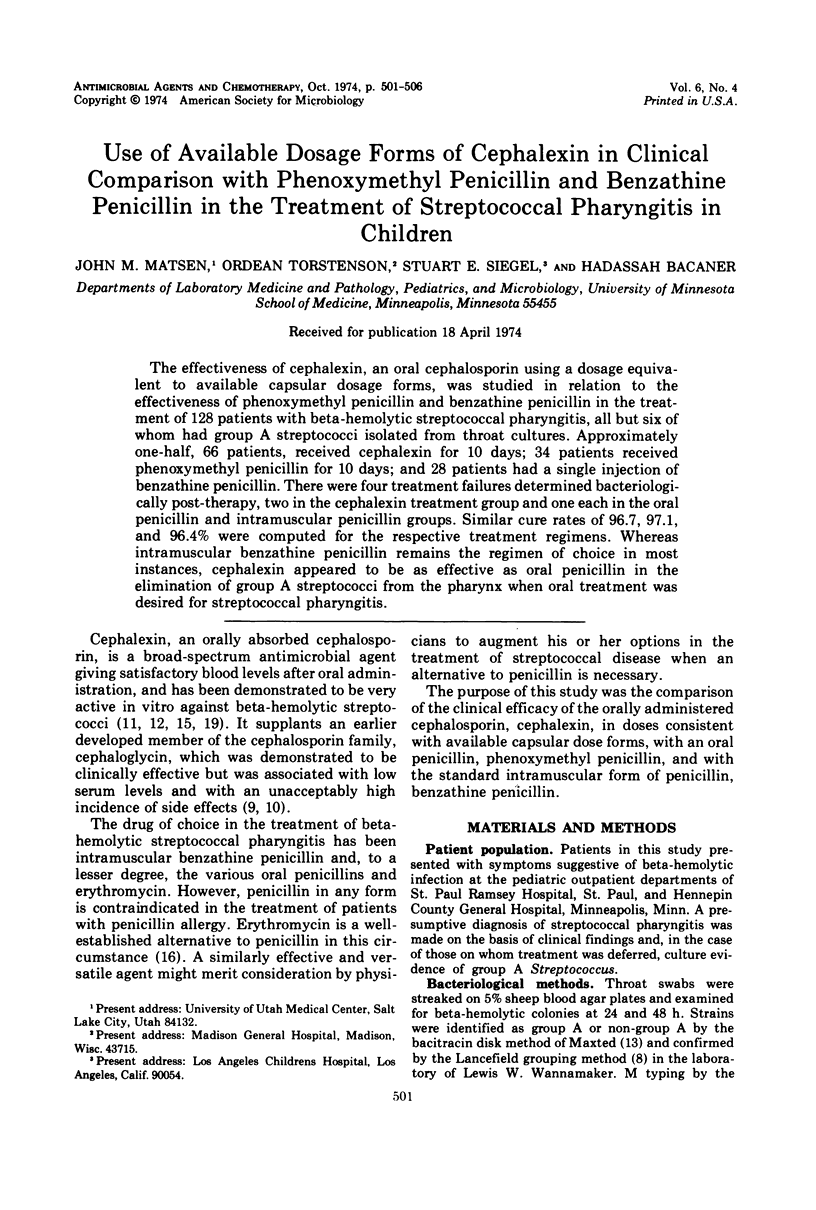
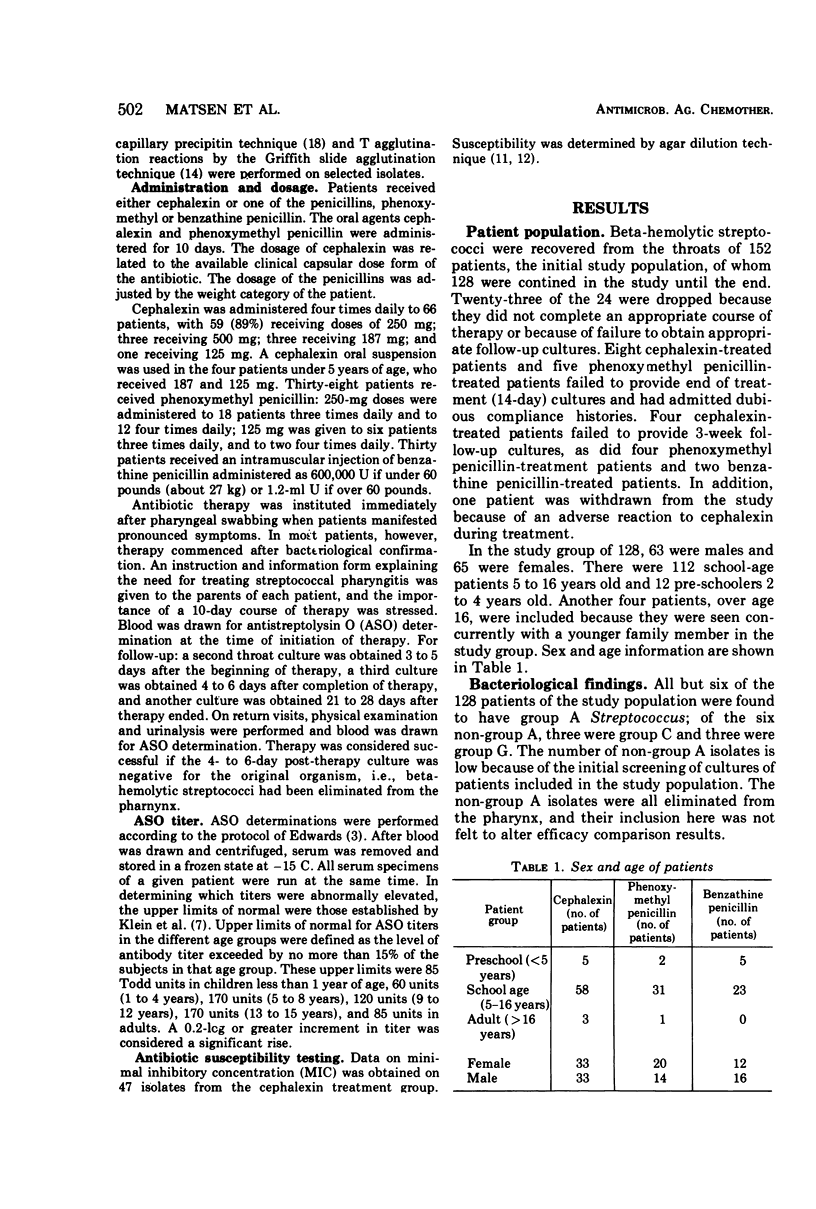
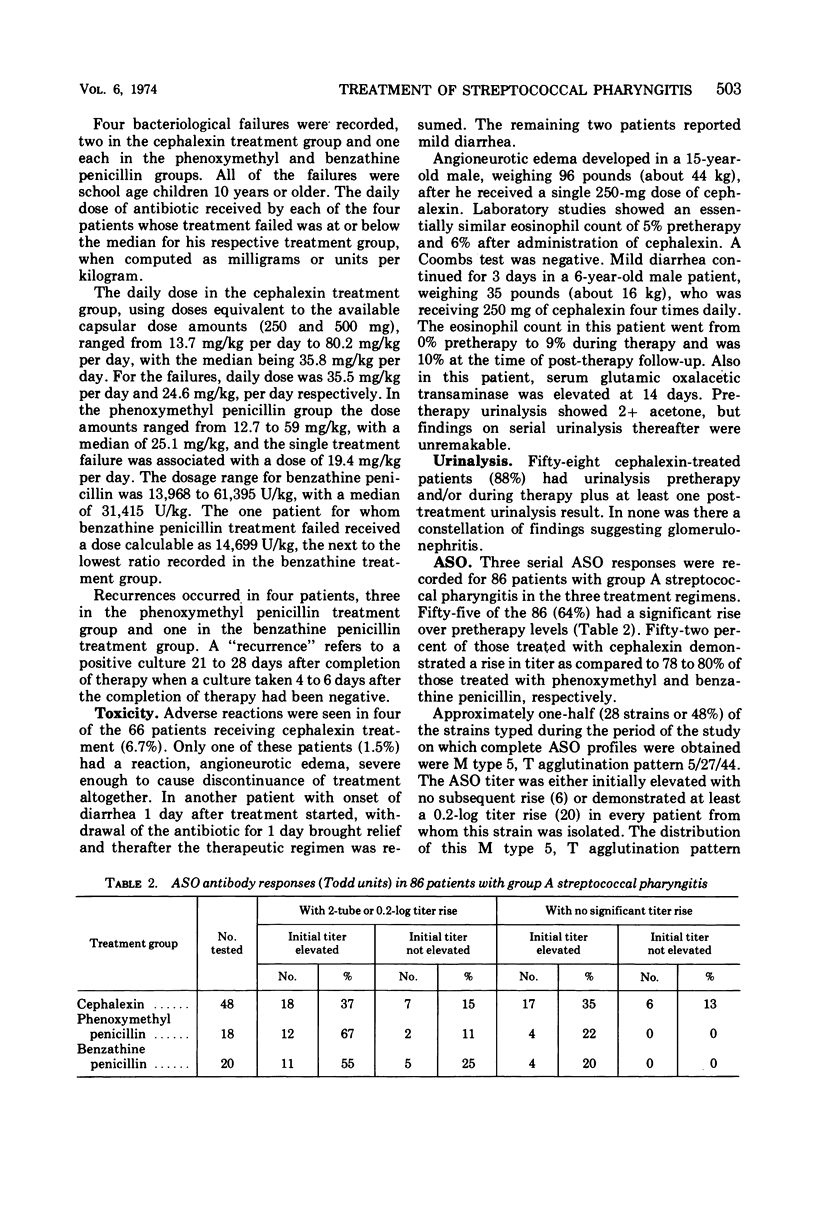

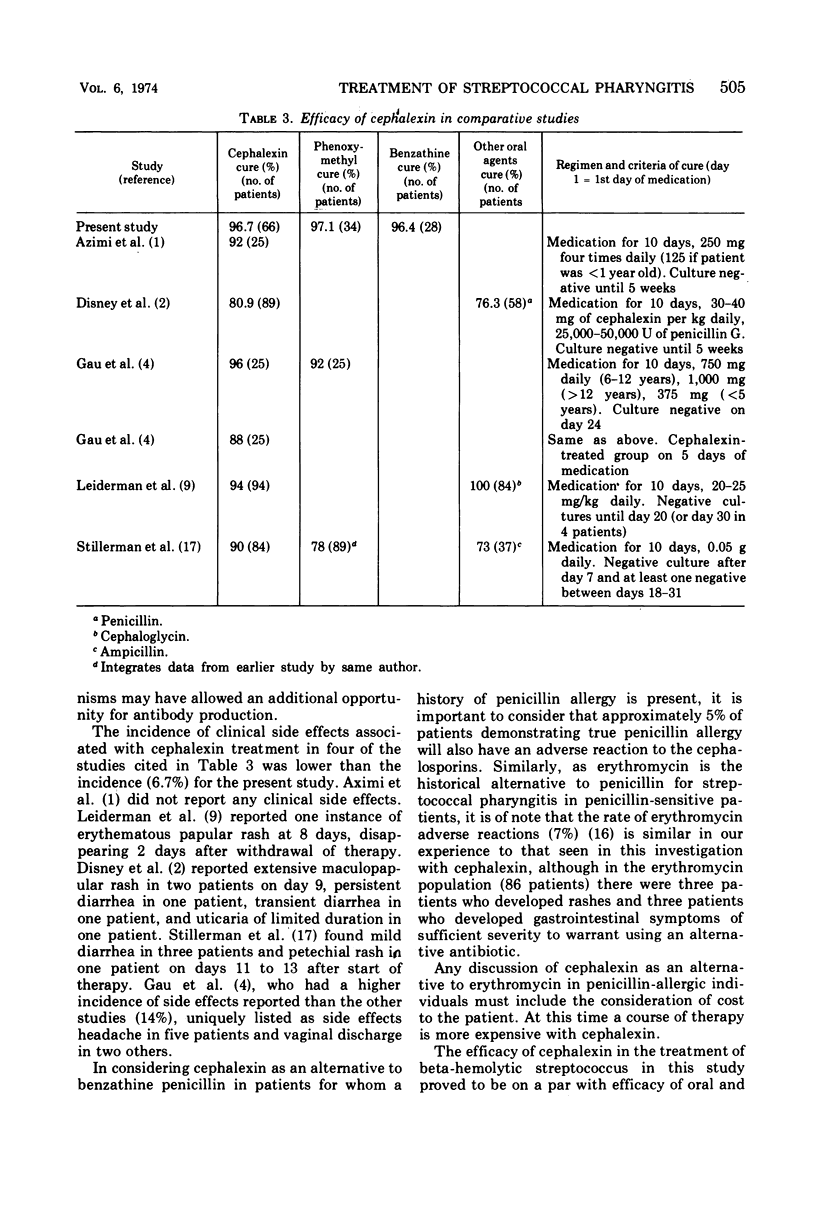
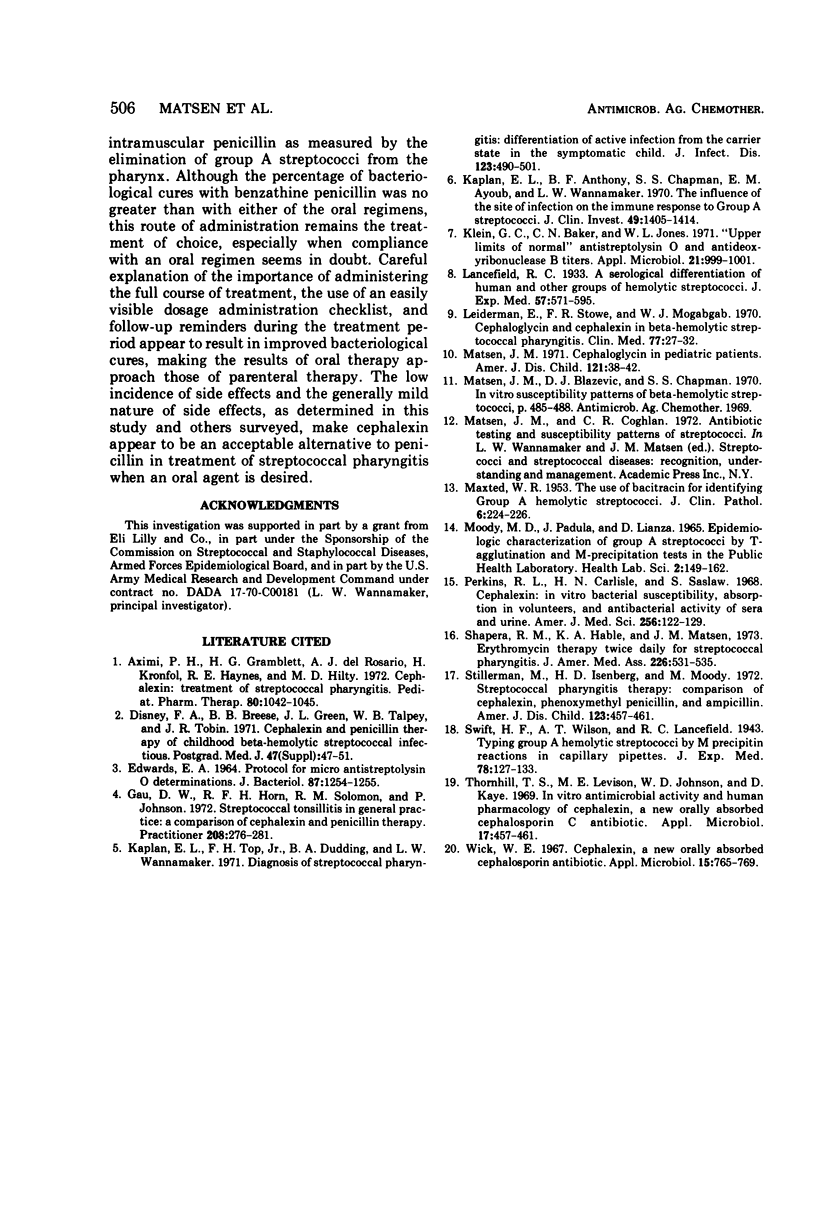
Selected References
These references are in PubMed. This may not be the complete list of references from this article.
- Azimi P. H., Cramblett H. G., Del rosario A. J., Kronfol H., Haynes R. E., Hilty M. D. Cephalexin: treatment of streptococcal pharyngitis. J Pediatr. 1972 Jun;80(6):1042–1045. doi: 10.1016/s0022-3476(72)80026-x. [DOI] [PubMed] [Google Scholar]
- Disney F. A., Breese B. B., Green J. L., Talpey W. B., Tobin J. R. Cephalexin and penicillin therapy of childhood beta-hemolytic streptococcal infections. Postgrad Med J. 1971 Feb;47(Suppl):47–51. [PubMed] [Google Scholar]
- Edwards E. A. Protocol for micro antistreptolysin O determinations. J Bacteriol. 1964 May;87(5):1254–1255. doi: 10.1128/jb.87.5.1254-1255.1964. [DOI] [PMC free article] [PubMed] [Google Scholar]
- Gau D. W., Horn R. F., Solomon R. M., Johnson P., Leigh D. A. Streptococcal tonsillitis in general practice. A comparison of cephalexin and penicillin therapy. Practitioner. 1972 Feb;208(244):276–281. [PubMed] [Google Scholar]
- Kaplan E. L., Anthony B. F., Chapman S. S., Ayoub E. M., Wannamaker L. W. The influence of the site of infection on the immune response to group A streptococci. J Clin Invest. 1970 Jul;49(7):1405–1414. doi: 10.1172/JCI106358. [DOI] [PMC free article] [PubMed] [Google Scholar]
- Kaplan E. L., Top F. H., Jr, Dudding B. A., Wannamaker L. W. Diagnosis of streptococcal pharyngitis: differentiation of active infection from the carrier state in the symptomatic child. J Infect Dis. 1971 May;123(5):490–501. doi: 10.1093/infdis/123.5.490. [DOI] [PubMed] [Google Scholar]
- Klein G. C., Baker C. N., Jones W. L. "Upper limits of normal" antistreptolysin O and antideoxyribonuclease B titers. Appl Microbiol. 1971 Jun;21(6):999–1001. doi: 10.1128/am.21.6.999-1001.1971. [DOI] [PMC free article] [PubMed] [Google Scholar]
- MAXTED W. R. The use of bacitracin for identifying group A haemolytic streptococci. J Clin Pathol. 1953 Aug;6(3):224–226. doi: 10.1136/jcp.6.3.224. [DOI] [PMC free article] [PubMed] [Google Scholar]
- MOODY M. D., PADULA J., LIZANA D., HALL C. T. EPIDEMIOLOGIC CHARACTERIZATION OF GROUP A STREPTOCOCCI BY T-AGGLUTINATION AND M-PRECIPITATION TESTS IN THE PUBLIC HEALTH LABORATORY. Health Lab Sci. 1965 Jul;2:149–162. [PubMed] [Google Scholar]
- Matsen J. M. Cephaloglycin in pediatric patients. Am J Dis Child. 1971 Jan;121(1):38–42. doi: 10.1001/archpedi.1971.02100120074009. [DOI] [PubMed] [Google Scholar]
- Perkins R. L., Carlisle H. N., Saslaw S. Cephalexin: in vitro bacterial susceptibility, absorption in volunteers, and antibacterial activity of sera and urine. Am J Med Sci. 1968 Aug;256(2):122–129. [PubMed] [Google Scholar]
- Shapera R. M., Hable K. A., Matsen J. M. Erythromycin therapy twice daily for streptococcal pharyngitis. Controlled comparison with erythromycin or penicillin phenoxymethyl four times daily or penicillin G benzathine. JAMA. 1973 Oct 29;226(5):531–535. [PubMed] [Google Scholar]
- Stillerman M., Isenberg H. D., Moody M. Streptococcal pharyngitis therapy. Comparison of cephalexin, phenoxymethyl penicillin, and ampicillin. Am J Dis Child. 1972 May;123(5):457–461. doi: 10.1001/archpedi.1972.02110110085005. [DOI] [PubMed] [Google Scholar]
- Thornhill T. S., Levison M. E., Johnson W. D., Kaye D. In vitro antimicrobial activity and human pharmacology of cephalexin, a new orally absorbed cephalosporin C antibiotic. Appl Microbiol. 1969 Mar;17(3):457–461. doi: 10.1128/am.17.3.457-461.1969. [DOI] [PMC free article] [PubMed] [Google Scholar]
- Wick W. E. Cephalexin, a new orally absorbed cephalosporin antibiotic. Appl Microbiol. 1967 Jul;15(4):765–769. doi: 10.1128/am.15.4.765-769.1967. [DOI] [PMC free article] [PubMed] [Google Scholar]


